When you install the Microsoft OneDrive sync app for Mac, a copy of your OneDrive is downloaded to your Mac and put in the OneDrive folder. This folder is kept in sync with OneDrive. If you add, change, or delete a file or folder on the OneDrive website, the file or folder is added, changed, or deleted in your OneDrive folder and vice versa.
To upload files to OneDrive automatically, just copy or move the files to your OneDrive folder using the Finder, or save them in your OneDrive folder from an app. Files you upload this way can be up to 250GB in size if you're signed in to a Microsoft account, or 15GB if you're signed in to a work or school account. If you installed the OneDrive app on other computers, the files will automatically be added to the OneDrive folders on them, too.
You can also use the Finder to rename and delete files, create new folders, and move files around in your OneDrive folder. The changes will automatically be made in OneDrive and your other computers that have the sync app installed.
The sync app lets you sync files from your OneDrive for work or school and even from Microsoft SharePoint sites if your admin enabled it. (If you're the IT admin for your organization, see Enable users to sync SharePoint files with the new OneDrive sync app.)
Note: To use the sync app to sync your work files, you need a Microsoft 365 business account.
Notes:
-
OneDrive is supported on macOS devices with Apple silicon through Rosetta 2 emulation. For most users, no additional setup is needed to use OneDrive on a Mac with the Rosetta 2 emulator.
-
On November 10, 2020, Apple announced their new Macs using Apple silicon CPUs. If you're using a Mac that has the Apple silicon processor instead of the Intel processor, some Office features may not be available yet. For more information, see Microsoft 365 and Office 2019 support for Apple silicon
-
-
As of 1 February 2019, OneDrive only supports new installations on Mac OS 10.12 or newer. For more information, see OneDrive End Of Support Notice
Install and set up
If you have signed in to the OneDrive sync app with a Microsoft account (for example, someone@outlook.com), you should already have the sync app and you can skip to step 2 below.
-
Important: If you are currently using the OneDrive Mac Store app, you must first uninstall it before installing the latest build of the sync app.
-
Start OneDrive Setup.
Method 1: If you have no accounts signed in to OneDrive
If you're not signed in to OneDrive with any account, start OneDrive to connect a work or school account.
-
Start OneDrive by pressing cmd+Space to launch a Spotlight query and type OneDrive. This starts OneDrive Setup.
-
Enter your work or school account and then select Sign in to set up your account.
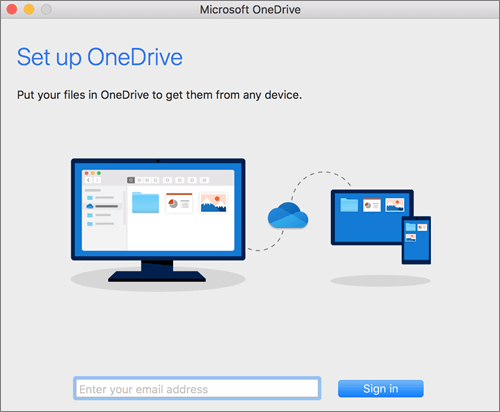
Method 2: If you already have a personal account signed in to OneDrive
If you already have a personal account signed in to OneDrive, you'll want to add a work or school account in OneDrive Preferences.
-
Click the OneDrive cloud icon up in your Menu bar, click the three dots to open the menu, and select Preferences.
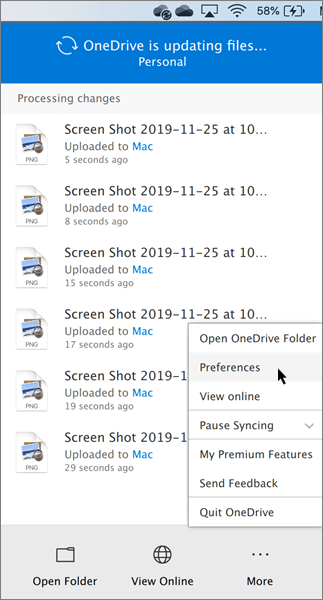
-
Click the Account tab, and then select Add an Account to start OneDrive Setup.
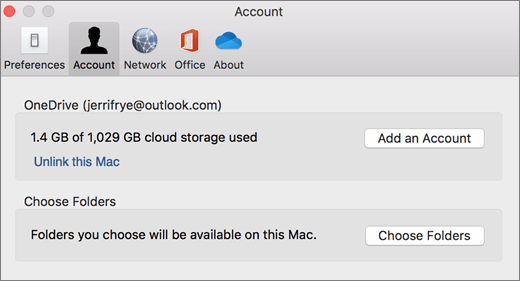
-
Enter your work or school account and click Sign in.

Key parts of OneDrive Setup
There are a few points of OneDrive Setup that are helpful to watch for:
-
When setting up your OneDrive, it has a default location set. However, you can change this during setup. On the This is your OneDrive folder screen, click Change Location.
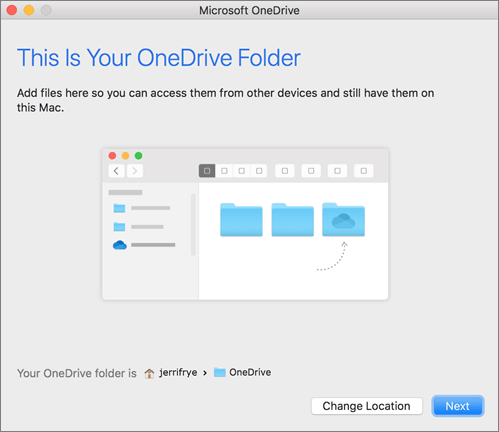
Select a location where you would like to save your OneDrive files and click Choose this location.
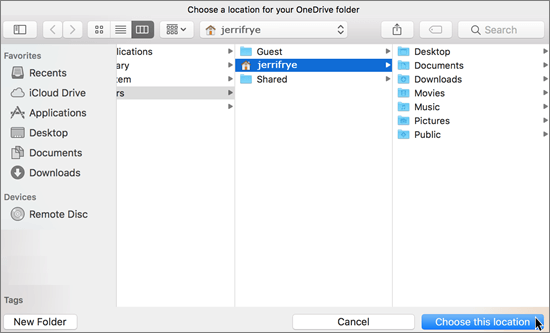
When you see the This is your OneDrive folder screen, you'll now see a path to the folder you selected. Click Next to continue.
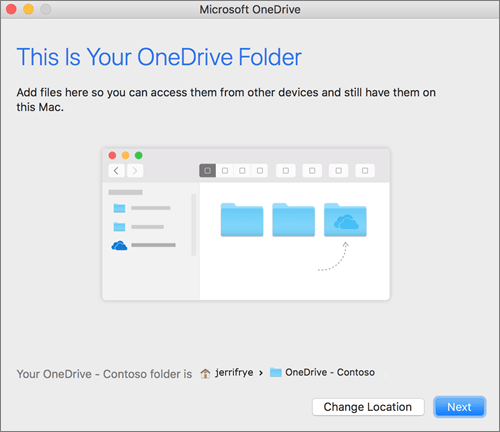
-
On the Sync Files from Your OneDrive screen, you can choose the folders you want to sync to your computer, and click Next. This conserves space on your computer, and reduces bandwidth needed for the sync processes.
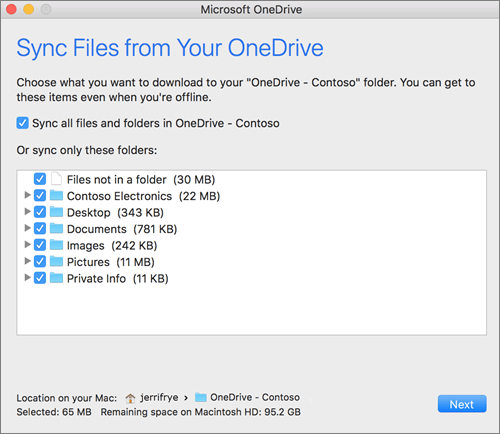
-
You're done! Click Open my OneDrive folder to see your files sync to your folder.
You can find OneDrive up in your Menu bar. You'll have a cloud icon for every account you've connected to OneDrive. So you'll have one cloud if you're only syncing a work or school account, one cloud if you're syncing only a personal account, or two clouds if you're syncing both.

You'll also see a folder in Finder called OneDrive – YourTenantName.
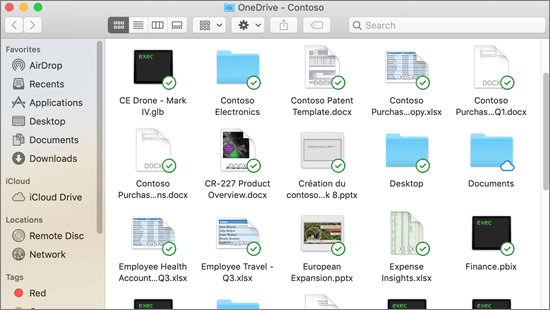
Note: Contoso is an example name. You will see the name of your organization.
Turn on Finder integration
If you're on OSX 10.10 or higher, get sync status directly from Finder by enabling Finder overlays in Settings.
First, click the Apple logo in the top left corner of your Mac Desktop and select System Preferences, then select Extensions in the top-level menu (shown in the 3rd row from the top).
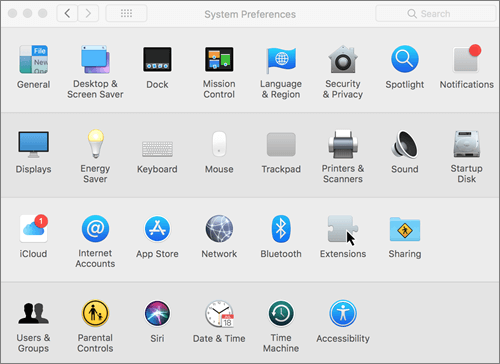
Toggle on the OneDrive Finder Integration to enable Finder overlays.

You're all set. Open up your OneDrive folder in Finder to see overlays on your files and folders.

If you're an admin and want to enable sync icon overlays on multiple computers, you can use this Terminal command:
/usr/bin/pluginkit -e use -i com.microsoft.OneDrive-mac.FinderSync
Sync SharePoint sites
To sync libraries and folders
-
Click the Microsoft 365 app launcher
 , and then click SharePoint.
, and then click SharePoint.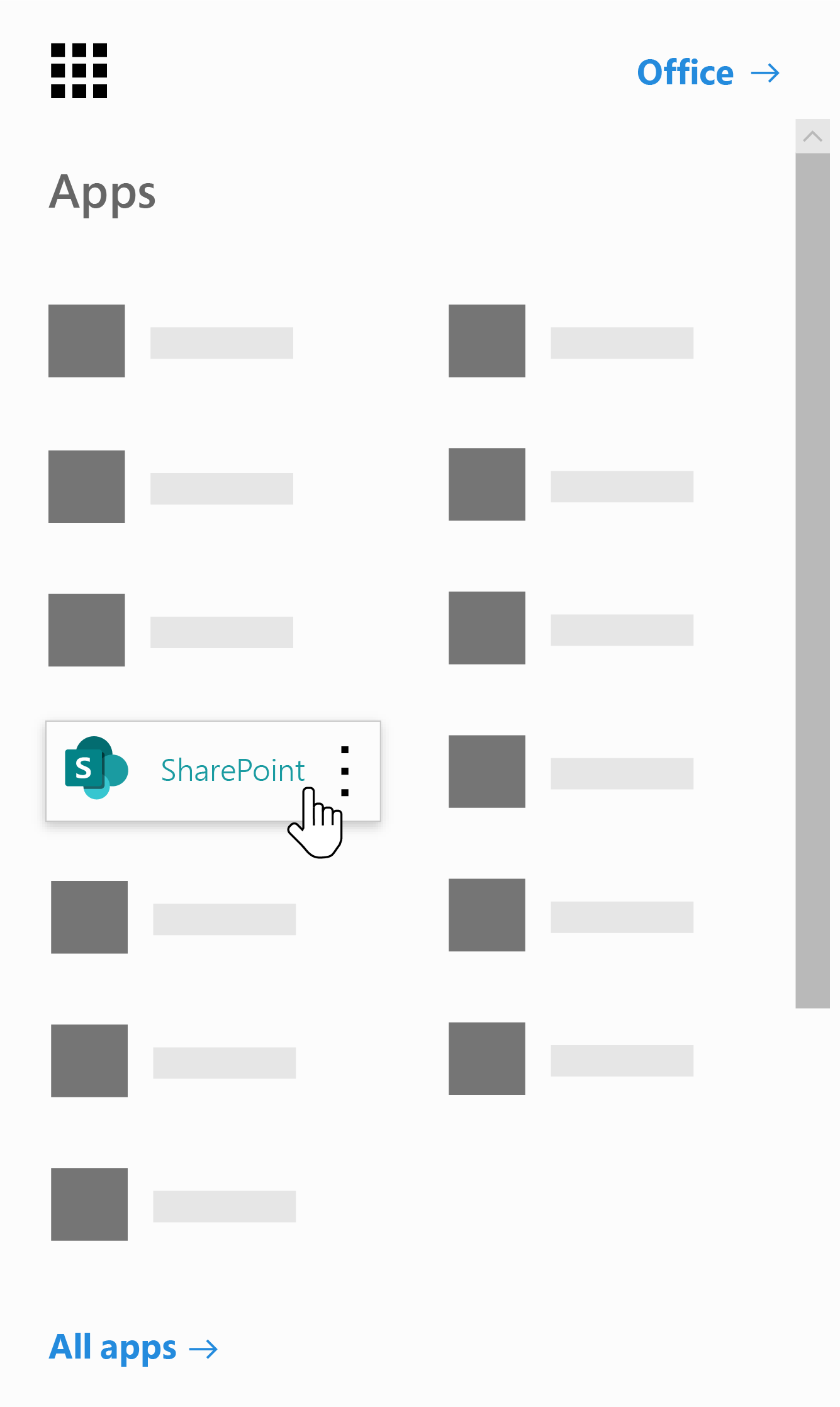
-
Click the site that you want to sync.
-
Click Documents or navigate to the subfolder that you want to sync.
-
Click Sync.

-
If your browser requests permission to use "Microsoft OneDrive," confirm that this is okay.
Note: Your organization needs to enable SharePoint site syncing with the sync app for you to sync sites on your Mac. If you're the IT admin for your organization, see Enable users to sync SharePoint files with the new OneDrive sync app. If you're not the IT admin, contact your IT department.
-
Choose the folders that you want to sync, and then click Start sync.
SharePoint team sites sync under a folder with your tenant name. This folder is automatically added to the left navigation pane in Finder.
Manage your syncing sites
You can manage your syncing sites in the sync app settings.
-
Click the OneDrive icon in the menu bar.
-
Click Preferences, and then click the Account tab.
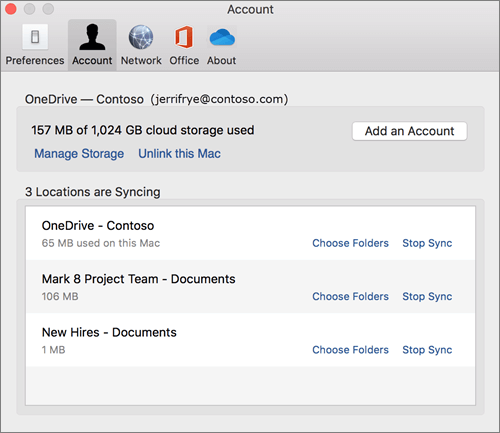
-
To change the folders that you're syncing, click Choose Folders for that location, and then choose the folders that you want to sync. To stop syncing a site, click Stop Sync next to the site. (Copies of the files remain on your computer. You can delete them if you want.)
Additional resources
For additional resources about the sync app:
| Title | Description |
|---|---|
| Learn how administrators can deploy the sync app on OS X to users in their enterprise environment. | |
| Release notes about the sync app. | |
| Invalid file names and file types in OneDrive, OneDrive for Business, and SharePoint | Knowledge base article covering limits and restrictions (such as invalid characters in file names). |
Need more help?
| | Contact Support For technical support, go to Contact Microsoft Support, enter your problem and select Get Help. If you still need help, select Contact Support to be routed to the best support option. | |
| | Admins |


Microsoft Office Tutorials: Sync Files With Onedrive On Mac Os X >>>>> Download Now
ReplyDelete>>>>> Download Full
Microsoft Office Tutorials: Sync Files With Onedrive On Mac Os X >>>>> Download LINK
>>>>> Download Now
Microsoft Office Tutorials: Sync Files With Onedrive On Mac Os X >>>>> Download Full
>>>>> Download LINK uw